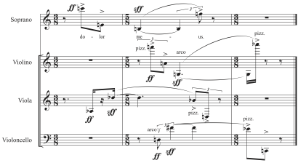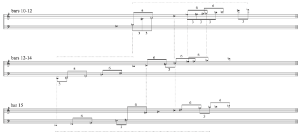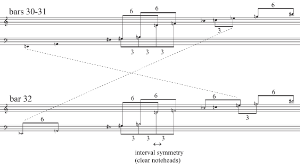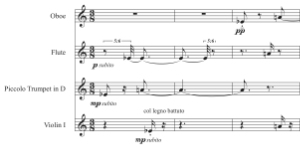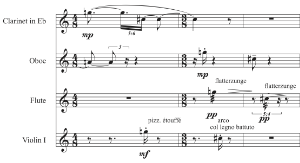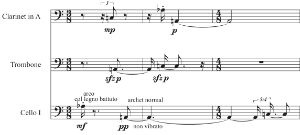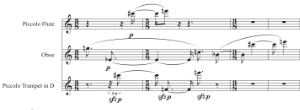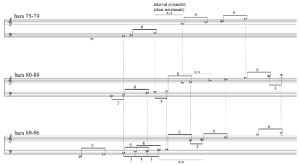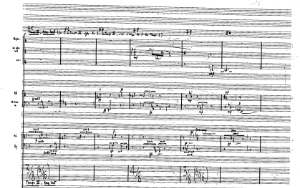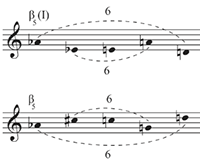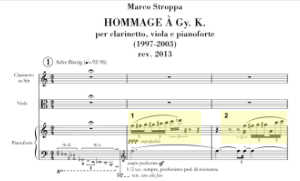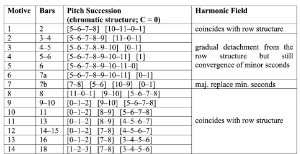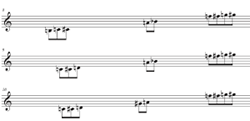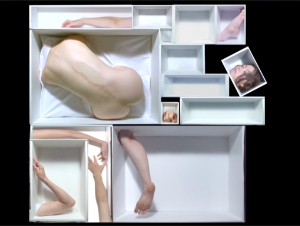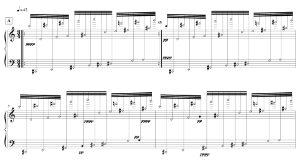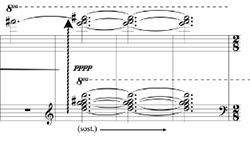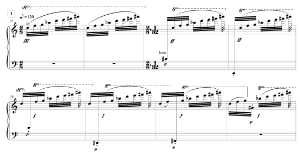EXAMPLE TESTING
Example 1. Henri Pousseur, Trois chants sacrés, transcription of the end of the second movement
(click to enlarge)
Example 2. Pierre Boulez, Polyphonie X, first movement, harmonic fields mm. 10–15; the pitch registration causes a gradual detachment of the tritone from the minor third
(click to enlarge)
Example 3. Pierre Boulez, Polyphonie X, first movement, mm. 10–15 (score in C), facsimile of the fair copy in the SWR Notenarchiv Baden-Baden, D 4098
(click to enlarge)
Example 4. Pierre Boulez, Polyphonie X, first movement, harmonic fields mm. 30–32
(click to enlarge)
Example 5. Pierre Boulez, Polyphonie X, first movement, mm. 75–77 (score in C), tritone “imitations” in oboe, flute, trumpet and first violin
(click to enlarge)
Example 6. Pierre Boulez, Polyphonie X, first movement, mm. 78–80 (score in C), tritone “imitations” in clarinet, oboe, flute and first violin
(click to enlarge)
Example 7. Pierre Boulez, Polyphonie X, first movement, mm. 79–81 (score in C), low-registral minor third “imitations” in clarinet, trombone and first cello
(click to enlarge)
Example 8. Pierre Boulez, Polyphonie X, first movement, mm. 82–85 (score in C), high-registral minor third “imitations” in piccolo flute, oboe and trumpet
(click to enlarge)
Example 9. Pierre Boulez, Polyphonie X, first movement, harmonic fields of the first Assez lent section (mm. 75–96).
(click to enlarge)
Example 10. Pierre Boulez, Polyphonie X, first movement, mm. 75–80 (score in C), facsimile of the fair copy in the SWR Notenarchiv Baden-Baden, D 4098
(click to enlarge)
Example 11. Pierre Boulez, Polyphonie X, prime form of fφ
(click to enlarge)
Example 12. Pierre Boulez, Polyphonie X, mm. 1–15, transpositions of fφ(I) per instrumental group (numbered 1–7, group 6 being silent); the table indicates the first pitch class of each transposition
(click to enlarge)
Example 13. Pierre Boulez, Polyphonie X, segments of β5(I) and β5 used in mm. 75–79
(click to enlarge)
Example 14. Marco Stroppa, Hommage à Gy. K., first movement, mm. 1–8
(click to enlarge)
Example 15. György Kurtág, Hommage à R. Sch., first movement, transcription of the initial sixteenth-note motive in the clarinet, m. 1, notation in C
(click to enlarge)
Example 16. Marco Stroppa, Hommage à Gy. K., first movement, pitch class sequences and harmonic fields of every occurrence of the piano motive
(click to enlarge)
Example 17. Marco Stroppa, Hommage à Gy. K., first movement, harmonic fields of the first 7 instances of the piano motive
(click to enlarge)
Example 18. Marco Stroppa, Hommage à Gy. K., first movement, harmonic fields of instances 8–14 of the piano motive
(click to enlarge)
Example 19. Marco Stroppa, Hommage à Gy. K., first movement, harmonic fields of instances 15–27 of the piano motive
(click to enlarge)
Example 20. Kentaro Taki, Living in the Box (2012), screenshot of the video material that is reused in Yukiko Watanabe’s Living in the Box II (by courtesy of Mori Yu Gallery)
(click to enlarge)
Example 21. Yukiko Watanabe, Living in the Box II, mm. 1–4.
(click to enlarge)
Example 22. Yukiko Watanabe, Living in the Box II, harmonic fields A, B, and C
(click to enlarge)
Example 23. Yukiko Watanabe, Living in the Box II, mm. 71–74
(click to enlarge)
Example 24. Yukiko Watanabe, Living in the Box II, mm. 75–82
(click to enlarge)
Example 25. Yukiko Watanabe, Living in the Box II, mm. 105–7
(click to enlarge)
